The Kung Fu of Master Tofik, the Beautiful University Town of Mekelle, the Ancient Cities of Nejashi and Axum and Interview with Ethiopian Wushu Federation President Abdurahman Alakil, Museums, Suri Stick Fighting and a
 For The Rainbow Continent Kung Fu Friendship Tour Part 2: Welcome to Ethiopia, click here.
For The Rainbow Continent Kung Fu Friendship Tour Part 2: Welcome to Ethiopia, click here.
Tuesday, July 30th 2018 - On this fine day I had the great pleasure to be invited to Master Tofik’s Club in a slightly older part of town where he told me the main downtown area was about 10 years before the urban area where my hotel is located was built. He had picked me up at my hotel about 6:15 and 30 minutes later, as we entered his neighborhood, I saw literally hundreds of people in the streets of all ages, some merchants selling vegetables and fruits or household items, children playing, couples strolling, older folks relaxing and I gotta report the over-all feeling was one of blissful peace and harmony. Driving there Tofik told me it was called the Italian part of town because a lot of Italians used to live there. I had that “time machine” feeling like I was transported out of the modern world into a simpler time of happy peaceful village life in spite of the appearance of an urban middle class neighborhood.
When we got to his 3-story school, it looked like maybe a 1980s guest house or small hotel with tall trees and attractive low brick wall with wrought iron above. Around the yard there were pine and other trees pointing gracefully to the sky.
As we entered the gate and walked into the building area first on the left in a covered veranda area, I saw four or so well-used pool tables with 15 or 20 teenage boys hanging out and casually playing. When we entered the building proper on the right, I saw a filled-to-capacity medium small gym with lots of free weights and some weight machines, running machines with folks running pretty enthusiastically and a small free exercise area on the left. Just inside the door on the right behind a desk was about the sweetest little old lady I ever saw who I guess is possibly in charge of collecting fees.
First Tofik introduced me to four people sitting on a bench just inside on the left, but because Amharic names are a bit difficult for me I can’t remember them for sure. However I can report one was a very nice lady with three men being in their 20s and 30s. These Tofik told me were some of his superstar Kung Fu players, national champions in fact, and I could tell also good friends. They welcomed me warmly and I instantly felt at home and comfortable.
After this Tofik had a couple of his guys demonstrate taolu in the free exercise area, both empty handed and with sword. They were superb and almost everyone in the gym stopped to watch and applauded enthusiastically at the end of each performance.
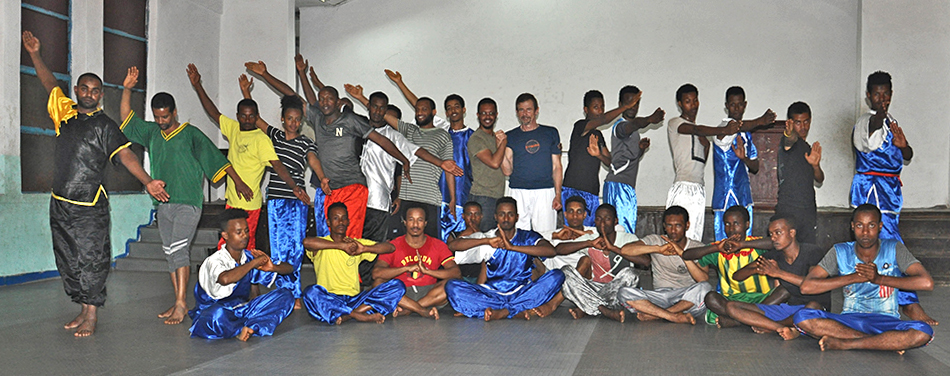
After about 15 minutes in the 1st floor gym, we went upstairs and it appeared a Taekwondo class was just finishing. Just a few minutes later, another started along with ours, so two martial arts classes were running at the same time on different sides of the gym.
True to form, I had volunteered to lead the class for the first 15 minutes or so starting with a stretching routine followed by some warm-up kicks, followed by some three and four kick/punch combinations. After that - like usual I turned the class back over to Tofik to see the master instructor at work. I gotta say he teaches with passion and precision. He knows how to motivate everyone to exceed their limits.
 First he demonstrated a combination, slowly, then at speed, and the students follow suit. When it comes to speed he knows how to get them cooking! He’s a great teacher I gotta say.
First he demonstrated a combination, slowly, then at speed, and the students follow suit. When it comes to speed he knows how to get them cooking! He’s a great teacher I gotta say.
Following about 30 minutes of training like this he had them practice pair sparring techniques, again, first very slowly, then with speed. I pitched in here and there helping students see where they were leaving openings (like dropping guard while attacking). I also introduced a few other combinations I like and have used in competitions.
Here I should mention that anytime the students saw something they really liked, they clapped. They can’t be fooled and definitely recognize and show appreciation for skill. All this was hugely fun for me - working with such great and enthusiastic students.
After all that Tofik asked me if I’d like to do anything else with the class and I chose one talented student to practice a slow-motion sparring exercise I learned in my first Kung Fu classes some 45 years ago. In this exercise, one person is the attacker and the other the defender, and the defender cannot move his back foot. He can only evade, block or counter-attack into the attacker. I explained that anytime someone attacks, they leave an opening and the skill or art is to recognize that opening and kick and/or punch into it. I showed them you don’t need blocks, only precision guided attacks along the centerline. This works best in slow motion at the beginning but with experienced students can get quite fun later on when some speed is added.
First I took the defense role and showed what I meant by counterattacking up the centerline. It’s not so different I think from Bruce Lee’s “intercepting fist.” Then after five minutes of that I took the offensive role and showed how I use slow motion attack combinations to create openings. Within about two minutes I found a combination that worked three times in a row, even at very slow speed and the class applauded. We humans are creatures of habit and some of those habits do lead to vulnerabilities that can be exploited, thus the need for careful examination of all our habits!

My Kung Fu teachers back in the early 70s called this slow motion sparring the “chess of sparring.” It teaches us to detect and take advantage of openings in the attacker, recognize where we leave doors open when attacking and how to use combinations to open doors when attacking. Probably most Kung Fu teachers still teach this, I don’t know, but we all had fun with it.
This was about the end of the class and Tofik invited the students around to rest while he and I relaxed against the small wooden stage. He asked me if I could say a few words to the students about persistence in training. That was easy for me because being in my 60s, I know well the ultimate value of always training, especially when you don’t feel like it. I also talked a little about nutrition, introducing it by asking one young man how many pieces of fruit he’d eaten that day. I know from being a high school teacher that people - especially youngsters often forget to include enough fruits in their diets, and kind of pushed the “rainbow” diet philosophy of eating three or four different color fruits and vegetables every day. We all laughed a bit when I apologized if I sounded like their moms. The young man of course hadn’t eaten any fruit that day. I know kids of course, having been one for an overly long time. I also shared some insights about training when you don’t feel like it, knowing that’s when you need it most.
Like always, I asked Master Tofik to please share my Facebook name with everyone and invite them to send me invitations. Then we took some group photos and alas it was time to go. Such practice with different clubs is really the most fun thing I do. People thank me and I so honestly thank them back because it’s the students’ enthusiasm that makes teaching into a meaningful and pleasurable experience.
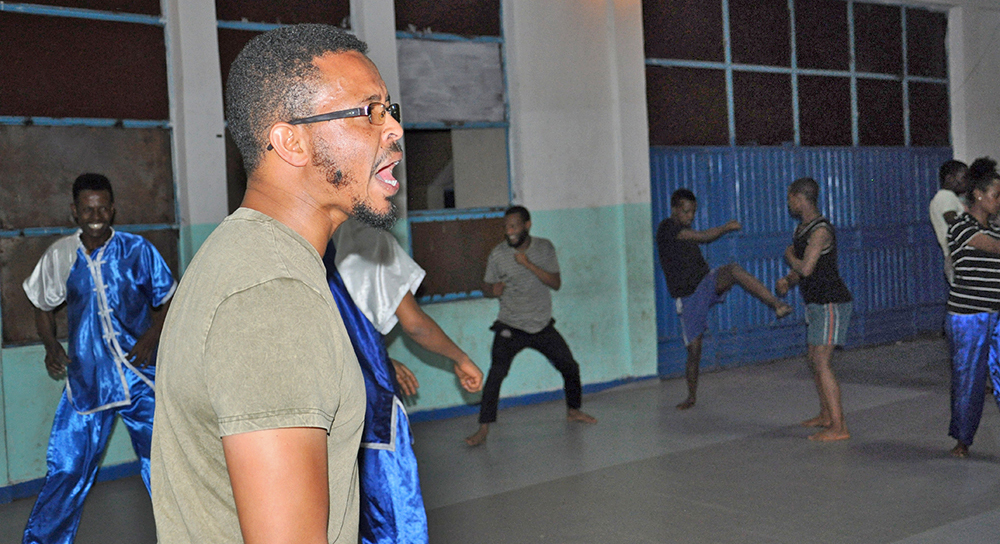
Driving to my hotel, I asked Tofik a few questions about the economics of being a Wushu teacher here in Addis Ababa. So he explained. He said he paid 3,000 birr per month to rent half the upstairs hall three evenings a week and the tuition of his 30 or so students basically paid the rent with nothing leftover. He did however earn some money from the gym downstairs. This is enough for him to support his family with not a lot leftover. In spite of what must be a limited income, he’s a happy healthy Shifu, and clearly respected and valued in his community and I gotta say, by me.
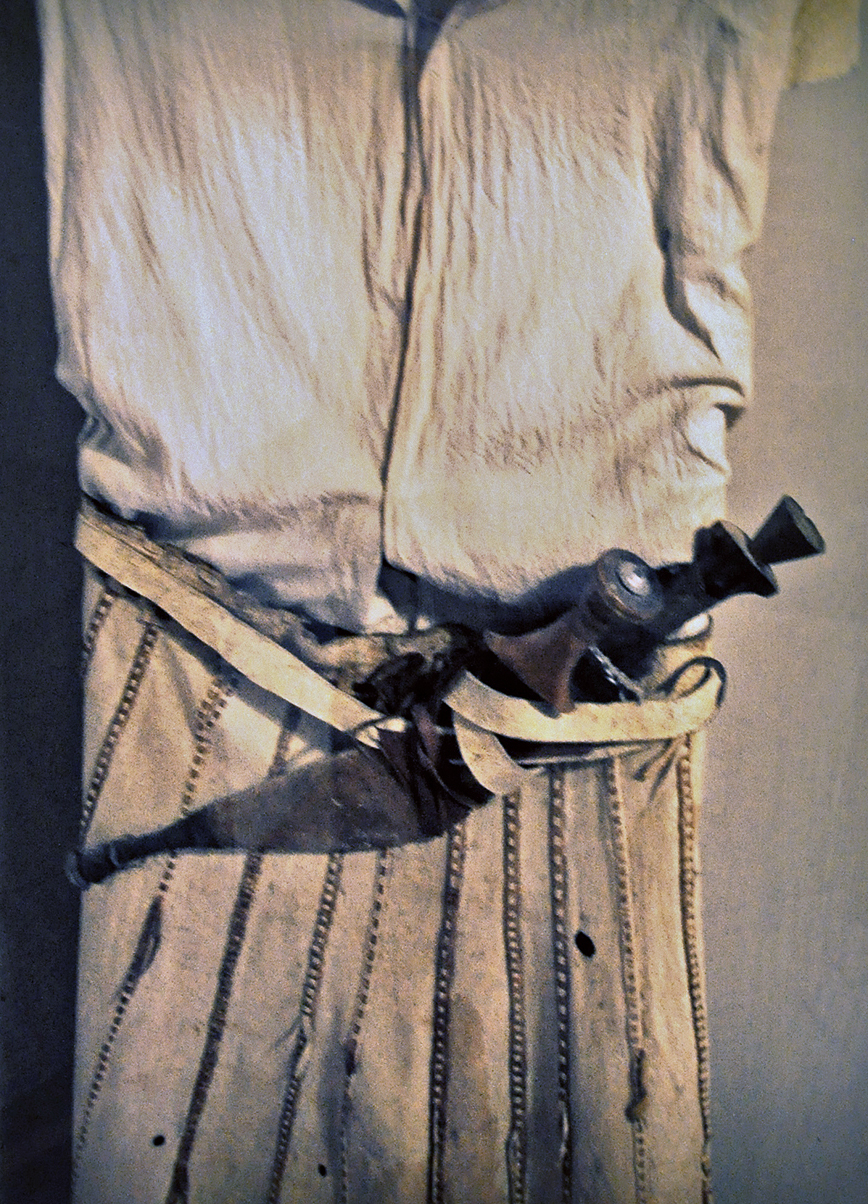
Mekele Emperor Yohanes Museum
Mekelle - Educational Center of North Ethiopia and Darned Nice Place
A couple of days later, I flew up to a town in the far north called Mekelle, the capital city of Tigray Province, and economic, cultural, and political center of northern Ethiopia. The population there is about 200,000 and they speak an ancient language called Tigrinya. By African standards it’s quite a new town dating back to only the 13th Century, when it was known as Enda Meseqel. Mekelle was actually quite comfortable without the hustle and bustle of the capital city Addis Ababa. Instead it’s a peaceful small/medium sized university town with clean streets and a well-educated relatively modern population.
Nejashi - Oldest Islamic Settlement in Africa
From there I took a bus to Wukro, about 45 km. away and then a taxi to Nejashi to visit the Nado Adi Masjid, the home of the most ancient Muslim settlement in Africa. Upon arrival I met Idriz a local guide that speaks English and also some Turkish engineers and workmen that built an exquisite small masjid near the site of the ancient one, and constructed a highly decorative mausoleum housing the tombs of 15 of the original settlers, and were in the process of building other structures for a more complete community. In fact the town around this ancient Muslim settlement is 95% Christian these days, but the people of these different faiths have lived harmoniously together for over 1300 years. Ethiopia has been a model of religious harmony at least since companions of the Prophet Mohammad were granted sanctuary here in the 7th Century ACE.
On the bus back to Mekelle, I met a young Ethiopian American lady that had just finished a two-year Peace Corps stay in Nejashi where she’d worked as a teacher. She filled me in on the life of the regular people there as she’d lived as a regular person, e.g. without electricity and associated amenities, and consequently like the regular people - only eating meat on holidays. She is a truly admiral lady indeed - and happy to return home to the USA I believe. How fortunate most westerners are to have such an option.

Writer in remains of most ancient masjid in Africa_Nejashi.
Axum - The heart of ancient Ethiopia
Back in Mekelle I stayed one more night and visited one more museum and then headed to the bus station where I decided to try a “big bus” instead of the ubiquitous white minivans one sees all over the country. What I didn’t know is that the big busses are much older and cheaper. So, I got the feel of the real Ethiopia sitting alongside regular people, none of whom spoke English, except the young man I happened to sit next to named Filimon, who I quickly learned is a student at Mekelle University.
He speaks excellent English, came across as quite bright and studies engineering. To compliment this good luck, he’s really from Axum and knows the history, for this ancient city was once the capital city of a great ancient empire on par in many ways with Greece, Rome and Egypt in regards to arts, culture, sciences and trade volume. Its origins date back to about the 1st Century BCE and it reached its zenith between the 4th and 7th Century CE. The bus ride was through lush green mountainous territory virtually all of which was cultivated farm land, in many cases with terraced irrigation systems to preserve the rainfall - essential in Sub-Saharan African which occasionally does suffer from droughts. What I saw was simply beautiful. Along the roadsides I also saw village and farm people walking often with donkeys and wooden carts not different in any way from a couple of thousand years ago, except perhaps one in a hundred of the people there might have a smart phone which were pretty much useless anyways as there was no signal anywhere around. Good riddance to all that (!) I thought.
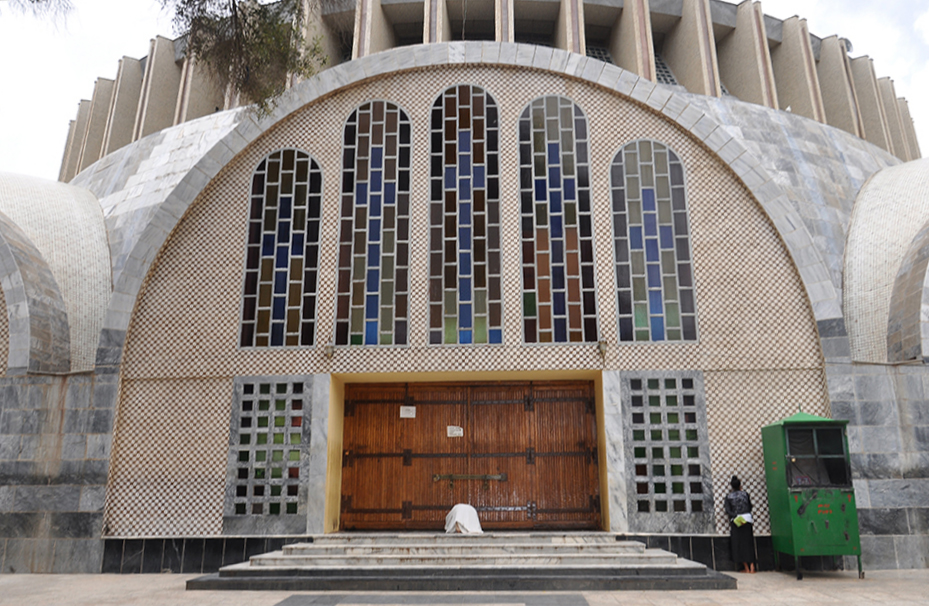
Church of Our Lady Mary of Zion in Axum.
When we arrived in Axum, Filimon and I were met by his friend KB Miller, his longtime buddy who is another brilliant young man and student at Mekelle University except he studies IT. For the next few days these gentlemen were my best friends and tour guides to the stunning history and contemporary culture of this awesomely beautiful town. Places we visited include:
-
St. Mary of Zion Church Complex - the most important church in Ethiopia and said to be the home of the Ark of the Covenant. Inside the circular dome are brightly colored murals, brilliantly illuminating the original ancient Ethiopian Tewahedo Orthodox (Christian) Church histories, and one can see locals praying in the traditional way, which actually looks rather like Islamic prayer using prayer rugs, kneeling and touching the ground with the forehead. There were only a few pews as the church’s main area was mostly open floor space.
-
Ancient Obelisks at the Northern Stelae Field right across from St. Mary’s, under which are or at least were secret tunnels my friends told me which once led to the:
-
Palace of the King of Sheba
-
Several underground tombs in which one may explore, also King Balkan’s Tomb said to have been one of the 3 Wise Men at Jesus’ birth.
-
The incredible Ezana Stone, named after King Ezana who ruled the Kingdom of Axum from 330 to 356 ACE, with script in Ethiopian Semitic Ge’ez, South Arabian Sabaean, and Greek, and is in some ways rather like the Rosetta Stone. This same King Ezana was converted to Christianity by his slave tutor Saint Frumentius, and later on King Ezana went on to bring down the ancient Kingdom of Kush. The writings on the Ezana Stone are praises to God and commemoration of victories in battles against the Nubians.
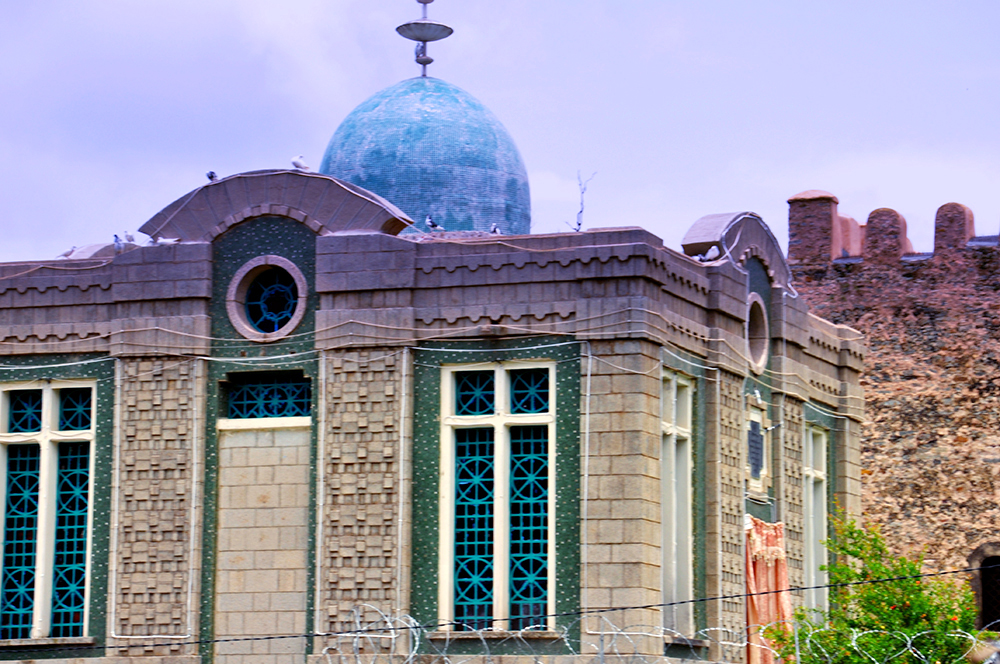
The building next to St. Marys that really houses the Ark of the Covenant.
I stayed in Axum for three days and Filimon and KB were most excellent companions. In addition to the most famous places listed above, they also took me to a small alleyway “café” where the lady roasted the beans for each cup and made coffee in the true traditional way. It was an absolutely heavenly brew! They also showed me some videos they’d made at their university, one of which was shown at the 9th All Africa University Games 2018 hosted by Mekelle University July 1 - 8. (Oh! Just missed it!) Their video was masterfully done for university students and hysterically funny so I’m including a link at the end of this story to the Youtube location where it can be found.
There are Kung Fu clubs in Mekelle but I had 2,000+ years of history to catch up on in this capital city of an ancient empire and only a few short days to grasp it all so alas I didn’t hook up with them. If anyone wants to find Kung Fu clubs anywhere in Ethiopia just contact Master Tofik as he’s one of the main coordinators with the Ethiopian Wushu Federation. His contact information can be found at the end of this story.
Oh! This is a huge country and it has so much to offer, wonderful people, delicious foods, places to see and things to do. But alas my time there was so limited and so I flew back to Addis from Axum Airport.
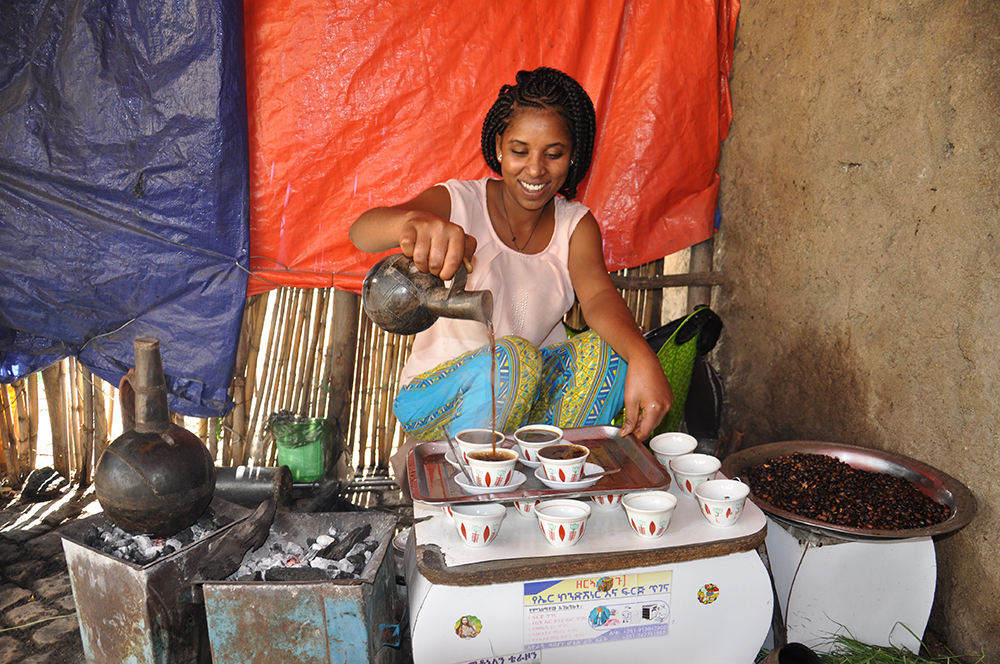
Making real coffee in Axum.
One thing I really wanted to do was visit the Surma (Suri) tribes in the south that are famous for stick fighting, but didn’t have time. They have inter-village competitions at harvest time, and sometimes inter-male competitions within villages, mainly I heard to settle disputes and sometimes just for the opportunity to catch the attention of some special young lady. I was told in most - but not all cases there’s a referee to ensure rules are followed. Google has lots of photos by the way. Next time I visit this lovely ancient and modern country I’ve got to visit the south. Its warmer there I heard and that’s where they grow most of the fruits and vegetables for the whole country. I’ve heard it’s truly like Eden.
The African Union headquarters are located in Addis Ababa in a huge compound that also houses a lot of - but not all of the United Nations offices. Due to my wide interests I also visited one of the UNHCR offices and OCHA (Office of the Coordination of Humanitarian Affairs).
In Addis the National Museum of Ethiopia is a “must see” location, wherein one can visit many of our pre-human ancestors including the highly-acclaimed Lucy resting peacefully near quite a number of other ancient links along the long dusty road to humanity.
Another thing I would love to have done but didn’t have the time is take a nature tour in Awash National Park where I was told one can see the large antelope Beisa Oryx, Soemmerring’s Gazelle, dwarf antelopes called Dik-Diks, Warthogs, Vervet monkeys, crocodiles, and the rare black and white Colobus Monkey - that for whatever reason, have no thumbs. All that said, I obviously have to go back. Fifteen days simply isn’t enough.
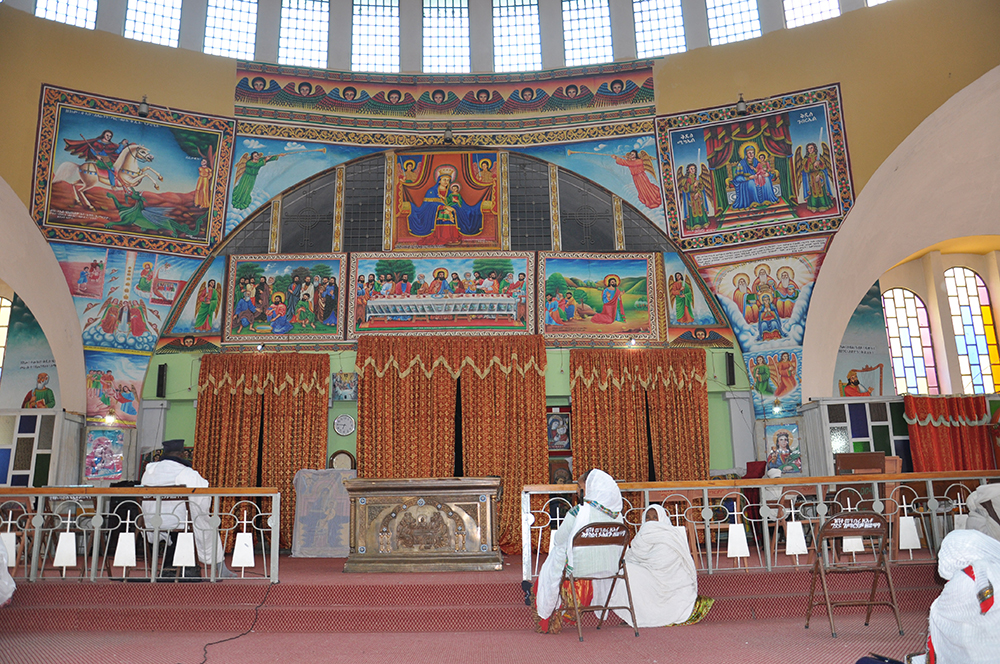
Interior of the church of St. Mary in Axum.
August 8, 2018 - Interview with Abdurahman Alakil
My last day in Ethiopia I was honored to have the opportunity to meet and interview one of the most extraordinary masters I’ve ever met, the Ethiopian Wushu Federation President Abdurahman Alakil.
Unlike many Wushu Federation Presidents he has an extensive martial art training background. His first Wushu training was many years ago with Tofik, and since then he trained at the Shaolin Monastery on Songshan and several other places including Tianjin and Beijing for differing lengths of time. His forte however is law and he attended the prestigious Renmin University in Beijing to obtain a Chinese Law degree in addition the law degree he earned here in Addis Ababa. No doubt mastery of law is a very powerful branch of Kung Fu which he applies by representing Chinese companies doing business here in Ethiopia. Abdurahman’s mastery of six languages, law and martial arts makes him a singularly unique individual - a master worthy of respect in any land.
Asked about the development of Wushu in Ethiopia he said “We have clubs in every city and small town in Ethiopia now. Also we have regular instructor training programs and I’ll be going to China August 28 this year to find out how to get Chinese instructors here to upgrade our judges training programs and certifications.”
I asked what kind of help he’s been getting from the Wushu Federation and he enthusiastically reported the Chinese Embassy in Ethiopia has been very supportive as well as the Ministry of Culture. On the subject of their champions getting to international competitions however I found out they still can’t afford it and their national team has only attended one in recent years. For now they’re building a solid, well-trained national base and when they do get the financing together there’s no doubt in my mind they’re going to make a huge impression on the international circuit.
During our hour interview we touched on many subjects including teaching Kung Fu to “mixed population” groups (refugees and under-privileged children) here in Addis Ababa in coordination with UNHCR. That however is still in the planning stages and hopefully may be implemented this fall.
Given the end of the war with Eritrea in the north, and the even more recent return of the Oromo peoples in the south, the future for Ethiopia is bright indeed. With a lot of planning and some help from upstairs hopefully more money can be invested in youth sports and I’m confident that Master Abdurahman has the will, community oriented mind and social networking resources to do it. After our interview I felt good about a brighter future here in this ancient and supremely beautiful land.
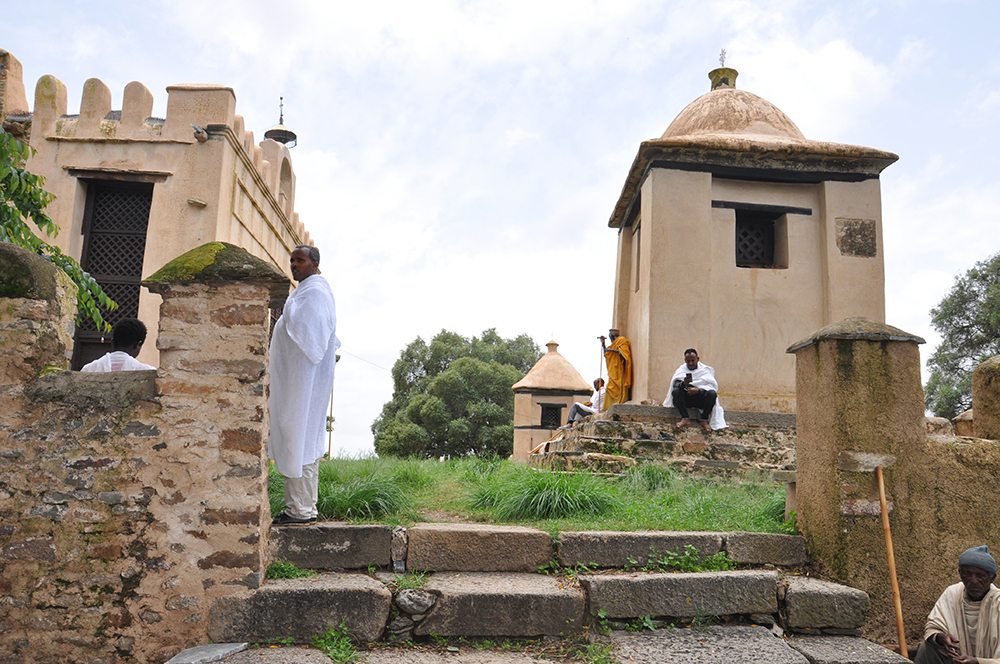
St. Pentalewon Monastery, Axum.
Lastly and I gotta say most sincere thanks to all the most excellent people I met during my short visit to Ethiopia, including Masters Tofik and Teshone, and TDK Master Adisu who hooked me up with these fine gentlemen, all the fantastic Kung Fu students I met at each of the clubs I visited, President of the Ethiopian Wushu Federation Master Abdurahman, Fili and KB there in the truly ancient Tigray region, the great people at Trinity Hotel in Addis who made me feel right at home, especially General Manager Getahun Tsegaye who really selected an incredible staff, other fantastic people I met along the road like Idriz in Nejashi, Awet in Wukro, the Peace Corps lady named Niwot Daniel, a Chinese engineer I met in Addis at a gym near my hotel named Steve Wu, and so many other people who helped me out on busses and the streets. Leaving such wonderful people is always difficult, but I feel better knowing I’m sharing some of the contacts I was so fortunate to meet with the readers in Kung Fu magazine and I hope you all plan a vacation soon to visit this magical unbelievably ancient land with such vibrant kind-hearted people. Life can be challenging indeed sometimes but the people of Ethiopia seem to know how to deal with it and somehow still exude a warm-hearted happiness that embraces all who come here.
Welcome home.
Contacts
Tofik Shumie - Ethiopia Wushu Coordinator - 251 91 116 1242 (Note: 251 is the international dialing code for Ethiopia - you’ll also need the prefix numbers before that used in your country for international calls. From here in China I dial: 00 251 91 116 1242) E-mail: tofikShumie@yahoo.com
Ethiopia Wushu Federation President Abdurahman Alakil - Email Tel: 251-912111302, abdu-al@hotmail.com
Filimon (Actually: Fili Renger Campton) - A lighthearted example of comedy/dance video by some Mekelle University students: “New Mekelle University Vines of 2018 [Part 2] - Camera Photographer KB Miller with Filimon as one of the actors dancers. Phone: 251914743662
Idriz: 251 93 582 6392 Tour guide for Nejashi, lives in Wukro - Expert in Nejashi Masjid complex, about the only English speaker there I know of, except for the Turkish engineers. He knows the local Muslim community and archeological sites. Local number 251 93 582 6390
Awet: 251 92 506 4004 Tour guide for Wukro and Axum - Good English, high IQ, good sense of humor.
About
Gregory Brundage :
![]() Gregory Brundage has had a 40 + year interest in and practice of Chinese Wushu, and an even longer interest in ancient civilizations and the Silk Road. He currently is a high school teacher in Beijing who travels the Silk Road in search of martial art masters on his vacations.
Gregory Brundage has had a 40 + year interest in and practice of Chinese Wushu, and an even longer interest in ancient civilizations and the Silk Road. He currently is a high school teacher in Beijing who travels the Silk Road in search of martial art masters on his vacations.
![]() Print Friendly Version of This Article
Print Friendly Version of This Article
















